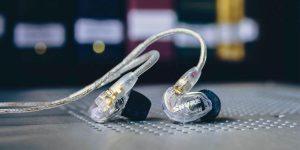For any spectacular performance, artists need an atmosphere in which they feel safe and comfortable, have the ability to hear themselves, and can make timely adjustments to their performance. Today, the main assistant and indispensable equipment of any live concert are acoustic systems of stage sound monitoring, and the most popular of them are floor wedge systems vs in-ear monitors.
It is impossible to say that wedge monitors are better or worse in their technical characteristics and capabilities vs in-ear monitors because both systems are effective in their own way and require a detailed analysis and evaluation, which we will do next.
Understanding in-ear monitors (IEMs)

Personal Sound Monitoring Systems (in-ear monitors) are small headphones or custom earpieces that allow performers to focus on the music, hear the finest details of their performance, and provide excellent isolation from outside noise. This type of system consists of a fixed transmitter backstage and a belt-worn receiver (about the size of a smartphone) and works by sending the signal from the mixer to your receiver, which the performer then listens to through the headphones.
There are certainly some advantages to in-ear monitors:
- Compactness and portability.
- In-ear monitors allow you to hear the mix in stereo, which means the output sound is much more intelligible and natural.
- The tight fit of the headphones provides excellent isolation from outside noise and allows the performer to control the volume of the overall mix and adjust the balance between different instruments and vocals.
- IEMs are an effective solution for reducing microphone feedback.
- They facilitate communication between band members and the engineer.
But be prepared:
- High-end IEMs can be expensive, especially with custom shapes and wireless options;
- You may need time to adjust to the feeling of isolation from the stage environment;
- The operation of these monitors is based on electronics, and technical glitches or wireless communication problems can occur.
Understanding wedge monitors

The floor-standing, performer-facing speakers that audiences often see on stage are called wedge monitors. In large venues, each musician or performer can have their own monitor, allowing them to hear their performance, as well as the overall sound of the other musicians, with clarity, dynamics, and presence.
Sound engineers adjust levels, EQ, vocal and instrument balance to create a personalized monitor mix, coordinating the preferences of all band members in advance. The input audio signal comes from the mixing console, is sent to the monitor’s internal amplifier, and is then distributed to the speakers inside the stage monitor enclosure.
Pros and cons of comparison
Next, let’s summarize the obvious advantages and disadvantages of each monitoring system: Wedge vs IEMs
| Wedge monitors | In-Ear Monitors | ||
| Pros | Cons | Pros | Cons |
| Ease of use | Insufficient isolation, resulting in a less clear monitor mix. | Excellent soundproofing and blocking of unwanted external noise. | Possible technical problems: battery failure or signal loss. |
| Strength and long service life | Volumetric | Compact and portable. | High cost. |
| Allow the group to communicate naturally. | Requirement of a clear position for the musicians on the stage. | Allows you to independently adjust and balance the monitor mix. | Getting used to isolation and management takes time. |
| A reliable backup audio source in case of technical problems with the IEM. | There is a risk of feedback from the microphone. | Minimize microphone feedback. | Need to get serviced on a regular basis. |
Like any device, these specialized tools have their pros and cons. Now, knowing this information, you will be able to make the right choice and use them to their maximum advantage.
Frequently asked questions
Can I use a combination of IEMs and wedge monitors in a live performance setup?
Yes, in-ear vs. stage monitors can be combined. This approach allows each musician to hear their mix through the headphones while still allowing the floor wedges to pick up important cues such as audience reaction and the overall sound of the band. In the event of technical problems with the IEMs, having wedge monitors as a backup can save the performance.
Are there any health or hearing concerns associated with using in-ear monitors (IEMs) for extended periods?
Prolonged use of in-ear monitors (IEMs) can cause hearing and health problems if precautions are not taken.
The following tips can help:
- Do not use headphones at maximum power for long periods.
- Practice basic hygiene.
- Regular audiological examinations to check your hearing may be useful.
- The use of a single in-ear speaker in combination with floor monitors will reduce the strain on the performer’s ears.





